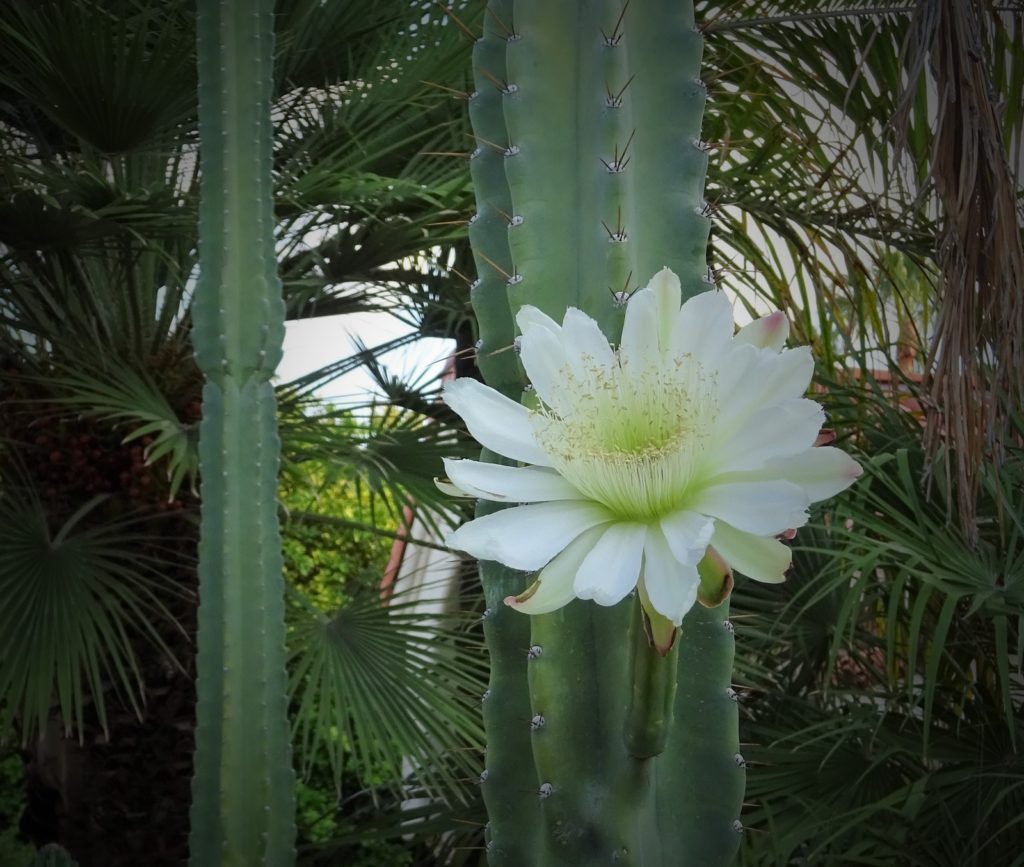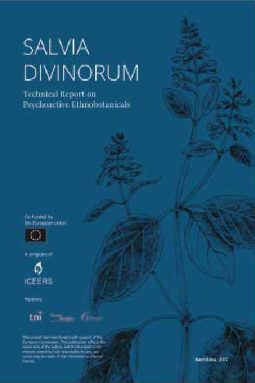Basic info
Echinopsis pachanoi is a cactus native to South America, with traditional religious and medicinal uses spanning more than 3,000 years. Out of the various alkaloids it contains, mescaline is responsible for its psychoactive effects.
San Pedro is a columnar cactus traditionally used for medical and religious purposes in certain parts of South America. Other cactus species that belong to the botanical genus Echinopsis (formerly called Trichocereus) are also known by this name, mainly Echinopsis pachanoi and Echinopsis peruviana, although there are other varieties such as E. puquiensis, E. santaensis, and E. schoenii.
San Pedro contains different alkaloids, including mescaline, a substance with psychoactive effects.
In traditional cultures it is known by different names, such as huachuma, achuma, wachuma, and aguacolla.
Origin/History
The earliest evidence of San Pedro use has been found in Peru, in the Guitarrero cave of the Callejón de Huaylas valley. Fossil remains of the cactus dating from 6800-6200 BCE have been found in these caves, including the presence of samples from different eras. Thus, the use of E. pachanoi is among the oldest of the different ancestral psychoactive plants.
At the Chavín de Huantar site, representations of San Pedro cactus engraved in stone have been found, along with textiles and ceramics, which suggest that its use was already understood and practiced. These objects date from the year 1300 BCE. Ceramics have also been found with representations of the cactus and archaeological evidence of the use of San Pedro in the Nazca, Cupisnique (1500 BCE) Chimú, Lambayeque (750-1350 CE) and Moche (100-750 CE) cultures has been discovered, along with the Chavín. It has been suggested that between 200 BCE and 600 CE. E. Pachanoi was domesticated and was being cultivated on the Peruvian coast.
The ongoing use of San Pedro until the Spanish colonial period can be deduced from the writings of the colonizers describing San Pedro’s effects when ingested by native peoples, and from archaeological evidence. Just as they did with mushrooms and peyote, the colonizers and the Catholic Church fought against the religious use of E. pachanoi.
Later, Christianity influenced indigenous ritual practices and E. pachanoi was named San Pedro and used in a syncretic way, blending traditional elements with Christian ones.
Thus, the San Pedro ceremony has existed for more than 3,000 years and possibly up to about 8,000.
Traditional use today
In Andean medicine, San Pedro continues to be used by different ethnic groups in Peru and Ecuador, such as the Saraguro, a group belonging to the Kichwa in Ecuador. Members of the community who know how to use medicinal and hallucinogenic plants are known as Yachakkuna, and the medical system of these communities is a blend of ancestral indigenous knowledge and modern medical methods. San Pedro is one of the therapeutic tools available, although many other plants and techniques are also used. San Pedro is considered a protector of families, marriage, and peaceful coexistence among family members, and for this reason it is usually cultivated close to homes.
The main use of San Pedro is for diagnostic reasons — the healer ingests San Pedro to be able to see the nature of the patient’s illness. Other uses include purification of the organism through purging, since the ingestion of the San Pedro decoction can produce vomiting and diarrhea, and as an anti-inflammatory in the form of a topical poultice.
The San Pedro ritual is known as a mesa, and it is done with the purpose of healing a sick person for whom normal treatment has not worked, or to obtain money, recover one’s lover or find lost objects or animals. A mesa consists of a set of objects that the healer has collected over time and that may include swords or machetes, staffs, stones, shells, the San Pedro preparation, sugar, tobacco, brandy, candles and other elements. These objects confer power to the healer.
Chemical composition and dosage
Mescaline is the primary alkaloid of the San Pedro cactus and hordenine, lophophine, DMPEA (3,4-dimethoxyphenethylamine), and lobivine have also been detected.
Mescaline is mostly concentrated in the green skin of the outer part of the cactus (called chlorenchyma), and the concentration of this alkaloid can vary greatly depending on the species and the specimen. Some analyses have found concentrations ranging from 0.053% to 4.7% of the total weight of the cactus. Thus the amount of San Pedro needed to induce psychoactive effects can vary considerably.
In the past, it was believed that E. peruvianus was much more potent than E. pachanoi, however, taking into account more recent analyses and a broad review of the different studies, this difference is not confirmed and it seems that the mescaline concentration in both species is very similar.
Dosage of mescaline:
The active dose of oral mescaline hydrochloride is between 150 and 700 milligrams. Customary doses of mescaline have been calculated based on 3.75 mg/kg of weight.
- Threshold dose: 100 mg
- Low dose: 100 – 200 mg
- Average dose: 200 – 300 mg
- High dose: 300 – 500 mg
Some analyses of traditional preparations have found doses ranging from 34 mg to 159 mg of total alkaloids, a relatively low and barely psychoactive amount. It appears that patients who receive traditional treatments with San Pedro ingest sub-psychoactive doses and do not experience psychedelic effects.
Effects
The effects of E. pachanoi are mainly due to the alkaloids it contains, in particular mescaline. The alkaloid content is similar to that of peyote, and therefore the subjective effects are similar as well.
San Pedro preparations tend to have a bitter and unpleasant taste, it is therefore not uncommon for nausea and vomiting to occur after ingestion, although mescaline itself may be the cause of some of these effects.
The psychological effects of San Pedro are usually described as being similar to those of peyote and mescaline, although the doses used traditionally do not seem to be high enough to produce a psychoactive experience. However, neo-shamanic groups use higher doses of San Pedro, so the effects that occur are similar to those produced by “classical psychedelics,” such as LSD and psilocybin. These include:
- Visions with eyes open and closed
- Deep change in cognition, perception, and consciousness
- Insightful psychological experiences
- Spiritual experiences
- Changes in the perception of time and space
Difficult experiences can occur, occasionally including anxiety and distress, although they seem to be less frequent than with other plants and substances.
Mescaline has a mildly stimulating effect, although some traditional reports speak of an initial state of lethargy after ingesting San Pedro.
Legal status
Mescaline, the psychoactive alkaloid of San Pedro, is a substance controlled by the 1971 Vienna Convention and is listed in Schedule I. It is therefore considered a substance whose use, sale and manufacture are prohibited. However, the San Pedro cactus is not included on the list of scheduled substances and its regulation depends on the legislation of each country.
For example, in Canada mescaline is on the Schedule III list and peyote (another cactus containing mescaline) is explicitly exempt from regulation if it is not prepared for ingestion, while in Switzerland, San Pedro is considered illegal. Other countries, such as Spain, do not mention peyote on their lists of controlled plants, although this does not imply that the sale of peyote is legal.
In most countries, the cultivation of San Pedro cactus is not prosecuted, while preparations, decoctions or extractions made for human consumption may be.
Health and risk reduction
The health and risk reduction concerns that must be taken into account when using San Pedro are equivalent to those that should be considered when using peyote, and to some extent, any other classical psychedelic, such as LSD or psilocybin mushrooms.
Physical health
Due to the possibility of intense experiences that may generate anxiety, people with a history of cardiovascular diseases should refrain from using San Pedro, particularly those who are taking medication to control these pathologies and who have medical conditions for which reduced amounts of physical activity have been indicated.
San Pedro has slightly stimulating effects, so it should not be combined with other stimulating substances.
Psychological health
As with any psychedelic substance, it is extremely important to consider three factors when it comes to reducing the risks associated with its use: the dose, the set (prior mental state) and the setting (the context in which it is used).
With regards to dosing, it is important to be aware that the effects of mescaline and San Pedro can take up to two hours to appear, so one could make the mistake of believing that the dose was insufficient, re-administer, and ultimately take too high a dose. It is important to calculate the dose in advance and wait a sufficient period of time before deciding to increase the dose.
As with any classical psychedelic, the effects of mescaline and San Pedro depend, to a large extent, on the mental state of the person who takes it. Some researchers have called psychedelics “nonspecific amplifiers of consciousness,” so their effects can be extremely variable from person to person, as well as on varying occasions. Therefore, caution must be taken when using San Pedro in situations of stress, depression, worry, or when experiencing life difficulties. In addition, the effects depend on the context in which these substances are used, as well as the company and the physical environment. For this reason, it is important to carefully plan the way in which San Pedro is going to be used.
People with a history of psychiatric conditions such as psychotic disorders, bipolar disorder, suicidal thoughts and others should refrain from using mescaline if it is not in a clinical context, as there is a risk of increased symptoms and decompensation.
As with any psychedelic substance, unconscious content may emerge during an experience with San Pedro. These processes can be emotionally intense and sometimes involve feelings of fear, distress and difficulty, in much the same way that they can cause experiences of joy and ecstasy. For this reason, it is usually recommended to have an open and accepting attitude towards the content of the experience.
Prevalence of use
Mescaline is an alkaloid that has been relatively well-known since the 1950s. Even so, the prevalence of consumption of mescaline has always been low, and the cacti that contain it are plants with very limited use compared to other traditionally-used psychoactive plants. The synthesis of mescaline or its extraction is more expensive, complicated, and less efficient in economic terms than that of other substances, so mescaline has not usually been offered on the black market, although some substances, such as LSD, have been sold in this way.
Unlike peyote, San Pedro grows rapidly, so it is not an endangered species and self-cultivation is much easier. Still, the use of San Pedro is very limited compared to other plants.
In the 2017 Global Drug Survey, mescaline does not even appear among the substances published in the report. In the survey carried out for the Psychēplants, out of a total of 593 users of psychoactive plants, 148 responded that they had used San Pedro; approximately 25%. This percentage is higher than less common plants such as khat, kratom, Argireya nervosa, the Daturas, Bufo alvarius, iboga and peyote, but lower than ayahuasca, psilocybin mushrooms and Salvia divinorum.
Categories:
PSYCHEPLANTS
, Others
, San Pedro
Tags:
San Pedro
, mescaline


